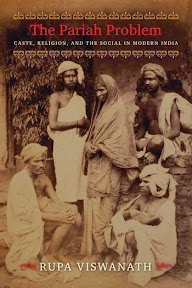Viswanath: The Pariah Problem
Viswanath, Rupa:
The Pariah Problem : Caste, Religion, and the Social in Modern India / Rupa Viswanath. - New York : Columbia University Press, 2014. - XVIII, 396 S.
ISBN 978-0-231-16306-4
US$ 60,00 (Hardcover)
ISBN 978-0-231-53750-6
US$ 59,99 (eBook)
DDC: 305.58660954
Beschreibung
Once known as "Pariahs," Dalits are primarily descendants of unfree agrarian laborers. They belong to India's most subordinated castes, face overwhelming poverty and discrimination, and provoke public anxiety. Drawing on a wealth of previously untapped sources, this book follows the conception and evolution of the "Pariah Problem" in public consciousness in the 1890s. It shows how high-caste landlords, state officials, and well-intentioned missionaries conceived of Dalit oppression, and effectively foreclosed the emergence of substantive solutions to the "Problem"--with consequences that continue to be felt today.
Rupa Viswanath begins with a description of the everyday lives of Dalit laborers in the 1890s and highlights the systematic efforts made by the state and Indian elites to protect Indian slavery from public scrutiny. Protestant missionaries were the first non-Dalits to draw attention to their plight. The missionaries' vision of the Pariahs' suffering as being a result of Hindu religious prejudice, however, obscured the fact that the entire agrarian political-economic system depended on unfree Pariah labor. Both the Indian public and colonial officials came to share a view compatible with missionary explanations, which meant all subsequent welfare efforts directed at Dalits focused on religious and social transformation rather than on structural reform. Methodologically, theoretically, and empirically, this book breaks new ground to demonstrate how events in the early decades of state-sponsored welfare directed at Dalits laid the groundwork for the present day, where the postcolonial state and well-meaning social and religious reformers continue to downplay Dalits' landlessness, violent suppression, and political subordination. [Verlagsinformation]
Inhalt
Preface on Terminology. xi
Acknowledgments. xiii
Abbreviations. xvii
Introduction. 1
1. Land Tenure or Labor Control? The Agrarian Mise-en-Scène. 23
2. Conceptualizing Pariah Conversion: Caste, Spirit, Matter, and Penury. 40
3. The Pariah-Missionary Alliance: Agrarian Contestation and the Local State. 71
4. The State and the Cēri. 91
5. Settling Land, Sowing Conflict; or, The Rise and Rise of Religious Neutrality. 118
6. The Marriage of Sacred and Secular Authority: New Liberalism, Mission-State Relations, and the Birth of Authenticity. 144
7. Giving the Panchama a Home: Creating "a Friction Where None Exists". 168
8. Everyday Warfare: Caste, Class, and the Public. 190
9. The Depressed Classes, Rights, and the Embrace of the Social. 217
Conclusion: The Pariah Problem's Enduring Legacies. 240
Glossary. 259
Notes. 261
Archival Sources. 345
Bibliography. 349
Index. 377
Vorschau
Autorin
RUPA VISWANATH is professor of Indian religions at the Centre for Modern Indian Studies at the University of Göttingen. She has held positions at the University of Pennsylvania and the University of Cambridge. Her interests include national minorities and practices of minoritization, comparative secularisms, slavery and race, transnational religious movements, religions and representative democracy, and political theory and the global south. Profile page.
Quellen: Columbia University Press; WorldCat; Google Books; Bookbutler; Library of Congress
Bildquelle: Columbia University Press
Bibliographie: [1]
References
- (2014). The Pariah Problem: Caste, Religion, and the Social in Modern India. XVIII, 396 S.
Ähnlich
- Lal: Coming of Age in Nineteenth-Century India
- Migration and Religion in Europe
- Swank: Rewriting Shangri-La
- The Jews of Andhra Pradesh
- Frauenbilder - Frauenkörper
- Handbook of Gender
- Writing India
- Die indische Diaspora in den Vereinigten Staaten von Amerika
- Gujarati Communities across the Globe
- Muslims in Indian Cities

